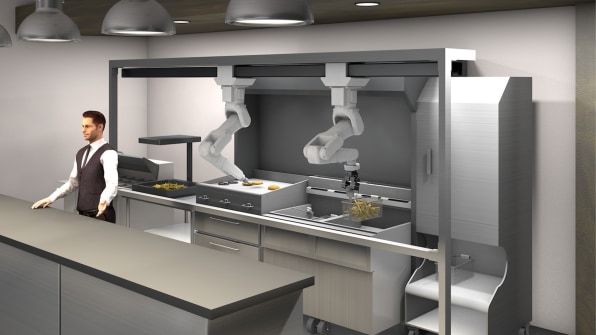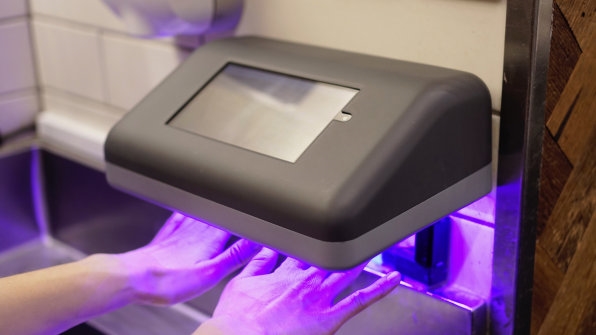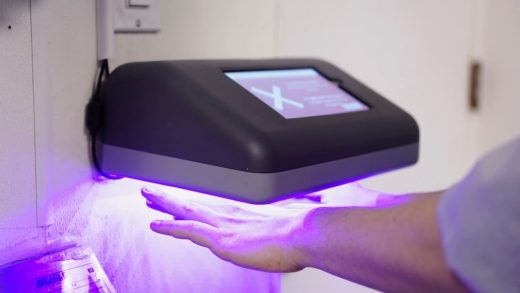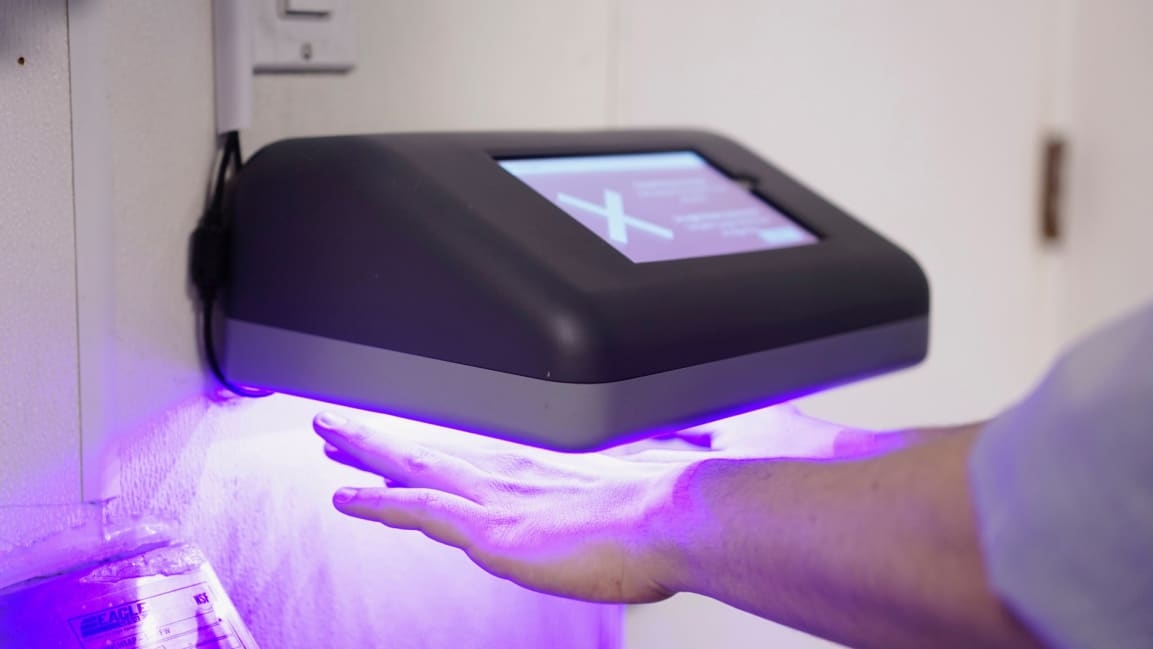In the post-pandemic world, your boss knows if you washed your hands
As restaurants start to reopen following the pandemic lockdowns, they’re going to need to implement new protocols for food handling and safety, both to prevent spread of the virus and to ensure wary customers that it’s safe to eat there. This will include things like temperature checks and mask wearing. And in some restaurants, that will mean employees to get your hands scanned to make sure you’ve washed them well enough.
Miso Robotics recently announced a partnership with PathSpot Technologies, which creates hand scanners that monitor handwashing frequency and effectiveness. That partnership will allow Miso, creator of the burger-flipping robot Flippy, to integrate PathSpot’s hand scanning devices into its latest design, Robot on a Rail, nicknamed ROAR. Unlike Flippy, which is a stationary machine in front of a kitchen grill, ROAR’s robotic arm is mounted to a rail, allowing it to move from station to station and lift up fryer baskets without taking up floor space.

The partnership was a natural fit for Miso, says CTO Ryan Sinnet, because the company has always been concerned with health and food safety, but the COVID-19 pandemic definitely accelerated the collaboration. “Our technology is an incredible boon, we believe, for food safety because it can keep track of time perfectly, it knows how long food is cooked, it can measure temperature with thermal cameras and thermometers, and the robots are doing more of the work, so there’s fewer times when there’s a potential for human-to-food transmission of pathogens,” Sinnet says. “Because of this current tragedy that we’re going through, this has become what big brands are obsessing about: How do we improve food safety?”
After washing their hands, a kitchen worker will scan them under the PathSpot device, which uses visible light fluorescence spectroscopy, like a blacklight does, along with a detection algorithm to identify contaminants on someone’s hand. The specific wavelengths of line the device shines don’t specifically identify viruses and bacteria, but they can spot the “host vectors,” says PathSpot CEO and cofounder Christine Schindler, which may carry such diseases, like fecal matter particles, which may transmit E. coli. After the two-second scan, the PathSpot device can provide real-time feedback, instructing someone to rewash and rescan their hands, and also can track workers by ID codes to provide data on who is washing their hands, how often they’re washing, and how effectively—as in, how often they pass or fail the scan.
All businesses are concerned about safety as they look to reopen, and the ways they’re considering addressing that may seem a bit dystopian—required masks at Disneyland aren’t very magical, people have pointed out, and reconfigured offices, mandatory temperature checks, and contact-tracing apps seem straight out of sci-fi movies. Keeping track of exactly who is washing their hands, and how often, may seem a bit ominous, as well.

Schindler, whose background is as a biomedical engineer, says that the tech is customizable—employers can choose to look at individual data, or they can look at broader metrics like handwashing frequency on the shift level or even weekly overviews—and that the tracking is meant to create a positive culture around food safety, not a punitive one. “We want to say ‘this location hit their thousandth hand wash,’ or ‘this person is so on top of their handwashing, they’re the hand washer of the week,’” she says. There are PathSpot raffles—each scan is an entry—and competitions with prizes. When things are tracked, they’re complied with more effectively, she says. “It also allows you to feel safer,” she says of employees. “You can look at the unit and say, ‘I know that everyone around me washed their hands today.’”
There haven’t been any known instances of food-borne transmission of SARS-CoV-2, the virus that causes COVID-19, says Nachiket Vaze, an ORISE fellow in food technology and research associate at the Harvard T.H. Chan School of Public Health, and these types of scanning devices are limited in that they can’t detect particular viruses or bacteria, which would be an important aspect in a pathogen-specific outbreak like the coronavirus pandemic.
Still, he thinks it may be a good tool from a social behavior aspect, in terms of making sure employees clean their hands properly. The spread of germs from hands to food accounts for 89% of outbreaks in which food was contaminated by food workers, per the CDC. “Any establishment that has people who interact with a lot of other individuals in some way or another, lets say a movie theater with a ticket taker or a security guard or someone who makes your food, obviously there’s a person-to-person transmission risk,” Vaze says. “Those employees need to be trained in order to minimize that risk. That’s why we see those ‘Employees must wash hands before returning to work’ signs in every bathroom.”
Sinnet echoed that this integration isn’t intended to foster disciplinary systems. Workers want to wash their hands, he says, but—like many people, especially before the coronavirus crisis—they may not know they’re doing so ineffectively. “With this partnership, we’re not looking to create a Big Brother-like system,” he says. “We’re looking to help workers improve skills on the job.”
Flippy ROAR, with the PathSpot integration, is expected to roll out later this year. Miso Robotics is still working on pricing, but Sinnet says the company recently reduced the cost of its system in half, to about $25,000, and is hoping to get that price point even lower. Flippy is currently deployed in a few CaliBurger locations as well as Dodger Stadium and Chase Field in Phoenix. PathSpot is already in a few hundred locations across the country, from quick-serve restaurants including Chopt to sit-down dining and food packaging facilities.
This partnership with PathSpot comes on the heels of another Miso recently announced with PopID, which facilitates contactless ordering through face pay kiosks and also uses thermal cameras to check people’s temperatures—which could be used for both restaurant patrons and employees. Both collaborations speak to a new way of operating for restaurants post-pandemic, and Sinnet thinks they’ll help in terms of health and safety beyond COVID-19, as well. “There may be some degree of return to how things were six months ago, but I would anticipate a lot of these [adaptations]—contactless payment, fewer human touchpoints, more sensing technology like PathSpot and certainly more automation,” he says. “I believe that this trend is only making it very obvious the need to adopt this technology.”
(34)



